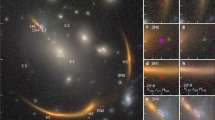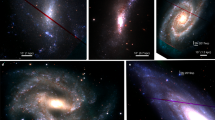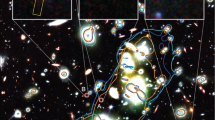Abstract
OBSERVATIONS indicate that nearby supernova of type Ia have similar peak brightnesses, with a spread of less than 0.3 mag (ref. 1), so that they can potentially be used as 'standard candles' to estimate distances on a cosmological scale. As part of a long-term search for distant supernovae, we have identified and studied an event that occurred in a faint member of the distant galaxy cluster AC118, at a redshift of z =0.31. Extensive photometry and some spectroscopy of the event strongly supports the hypothesis that we have detected a type Ia supernova whose time-dilated light curve matches that of present-day supernovae of this class. We discuss the precision to which its maximum brightness can be ascertained, and indicate the implications that such deep supernovae searches may have for observational cosmology.
This is a preview of subscription content, access via your institution
Access options
Subscribe to this journal
Receive 51 print issues and online access
$199.00 per year
only $3.90 per issue
Buy this article
- Purchase on Springer Link
- Instant access to full article PDF
Prices may be subject to local taxes which are calculated during checkout
Similar content being viewed by others
References
Sandage, A. & Tammann, G. A. in Supernovae as Distance Indicators (ed. Bartel, N.) 1–13 (Springer, Berlin, 1985).
Hansen, L., Nørgaard-Nielsen, H. U. & Jørgensen, H. E. ESO Messenger 47, 46–49 (1987).
Hansen, L., Nørgaard-Nielsen, H. U., Jørgensen, H. E., Ellis, R. S. & Couch, W. J. Astr Astrophys Lett. 211, L9–L11 (1989).
Tammann, G. in Supernovae; A Survey of Current Research (eds Rees, M. J. & Stoneham, R. J.) 371–403 (Reidel, Dordrecht, 1982).
Van den Bergh, S., McClure, R. D. & Evans, R. Astrophys. J. 323, 44–53 (1987).
Cappellaro, E. & Turatto, M. Astr. Astrophys. 190, 10–16 (1988).
Hansen, L., Jørgensen, H. E., Nørgaard-Nielsen, H. U., Ellis, R. S. & Couch, W. J. IAU Circ. No. 4641 (1988).
Hansen, L., Jørgensen, H. E., Nørgaard-Nielsen, H. U., Ellis, R. S. & Couch, W. J. IAU Circ. No. 4656 (1988).
Abetl, G. O., Corwin, H. G. & Olowin, R. P. Astrophys. J. Suppl. (in the press).
Couch, W. J. & Newell, E. B. Astrophys. J. Suppl. 56, 143–192 (1984).
Couch, W. J. & Sharpies, R. M. Mon. Not. R. astr. Soc. 229, 423–456 (1987).
Branch, D. et al. Astrophys. J. 270, 123–139 (1983).
Landholt, A. U. Astr. J. 88, 439–460 (1983).
Christian, C. A. et al. Publs astr. Soc. Pacif. 97, 363–372 (1985).
Leibundgut, B. thesis, University of Basel (1989).
Cadonau, R., Sandage, A. & Tammann, G. A. in Supernovae as Distance Indicators (ed. Bartel, N.) 151–165 (Springer, Berlin, 1985).
Pskovskii, Y. P. Sov. Astr. 21, 675–682 (1977).
Branch, D. Astrophys. J. 258, 35–40 (1982).
Pskovskii, Y. P. Sov. Astr. 28, 658–664 (1984).
Knude, J. K. Astrophys. Lett. 18, 115–118 (1977).
Thuan, T. X. & Gunn, J. E. Publs astr. Soc. Pacif. 88, 543–547 (1976).
Author information
Authors and Affiliations
Rights and permissions
About this article
Cite this article
Nørgaard-Nielsen, H., Hansen, L., Jørgensen, H. et al. The discovery of a type Ia supernova at a redshift of 0.31. Nature 339, 523–525 (1989). https://doi.org/10.1038/339523a0
Received:
Accepted:
Issue Date:
DOI: https://doi.org/10.1038/339523a0
This article is cited by
-
Supernovae and their cosmological implications
La Rivista del Nuovo Cimento (2022)
-
The Evidence for the accelerating universe: endorsement and robust consistency
European Journal for Philosophy of Science (2020)
Comments
By submitting a comment you agree to abide by our Terms and Community Guidelines. If you find something abusive or that does not comply with our terms or guidelines please flag it as inappropriate.



